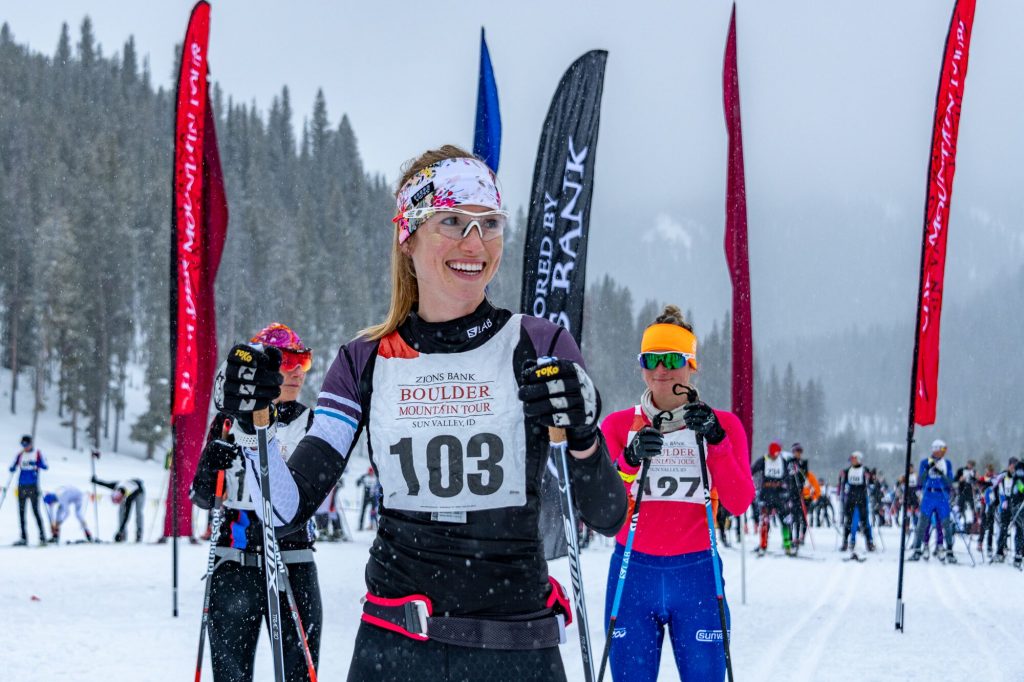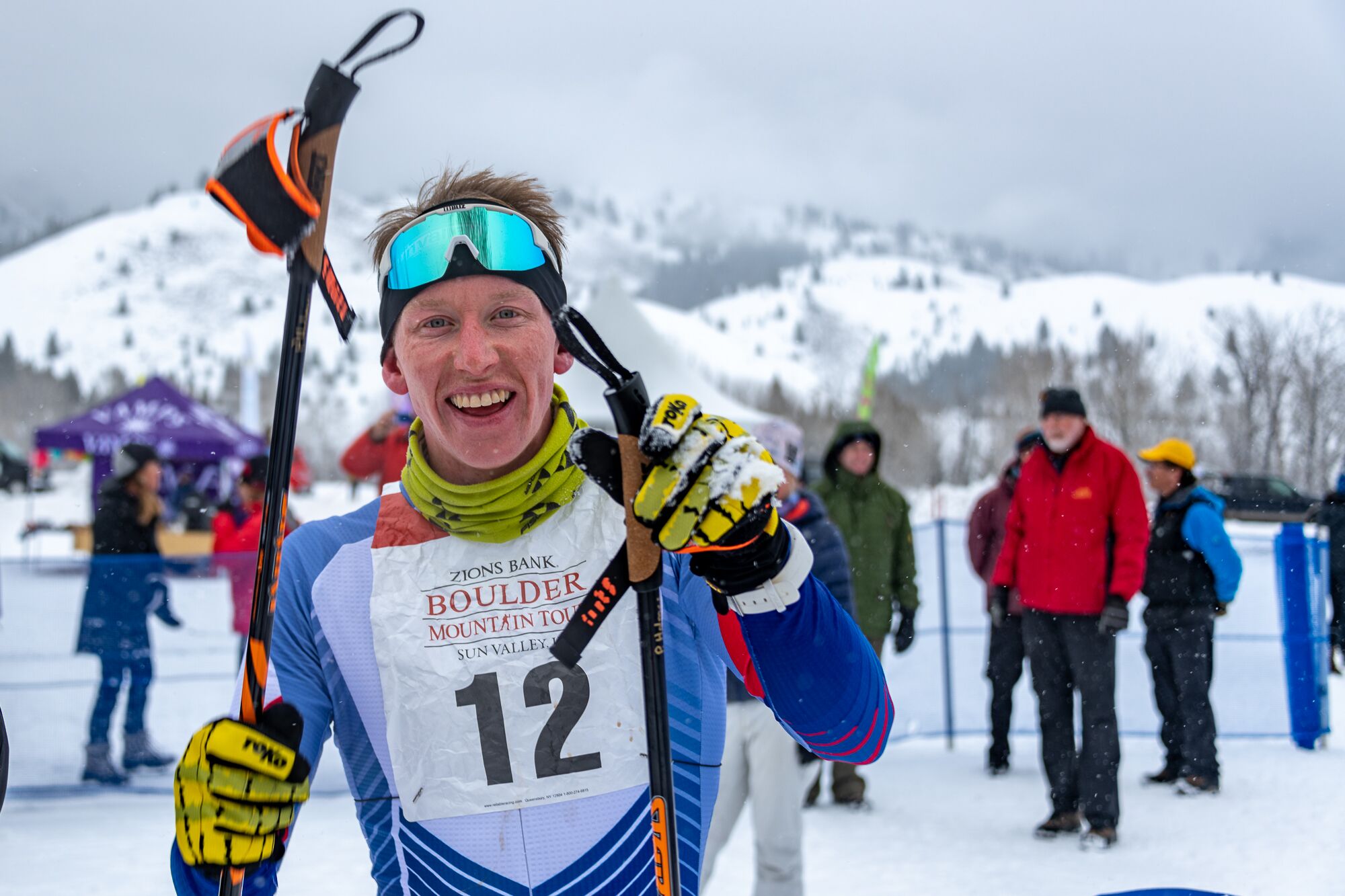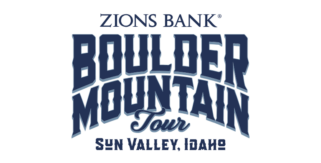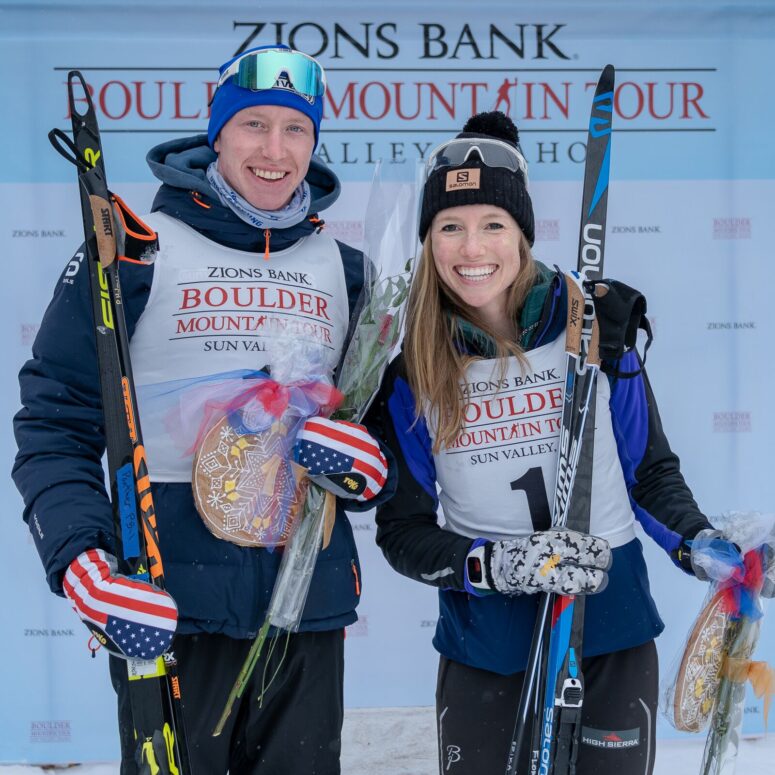BOULDER MOUNTAIN TOUR CHAMPS SHARE THEIR TRAINING PLANS
2019 Zions Bank Boulder Mountain Tour champs Erika Flowers and Peter Holmes know what it takes to train hard, build fitness and stay engaged over the long haul. They recently shared their training tips and methods with us and we are sure you will be as inspired (or tired!) as we were. Thank you, Erika and Peter!

Over the past 12 months, I’ve traded spandex for pointy shoes and boot bags for a black purse while making the transition from full-time athlete and racer to a more traditional work gig. Although ski training no longer dictates my day-to-day schedule, I continue to set goals and races for the summer and winter that guide my adventures outside the office. I loved ski racing professionally and even though it’s no longer my “job,” I’ve found I appreciate even more. Anytime I get out for a workout or race its 100 percent my choice and like peanut butter and granola, I’m completely addicted.
Balancing work alongside ambitious performance goals depends on consistency, quality and flexibility. They say “skiers are built in the summer” and putting in the work during the next 3-4 months sets the foundation for successful racing in the winter. My ski training today is less structured than when competing as a professional athlete but I tend to follow the same general training trends: volume and threshold in the summer, shifting to more L4 intensity and time-trials in the fall, all underlined by consistent and intentional strength training, mobility, and speedwork. I also refer to my husband and long-time ski racer Andy Newell and the Nordic Team Solutions website for workout and strength ideas specific to different times of the year.
Building a strong base for winter racing depends on getting out the door on a consistent basis. This summer I’ve mapped most of my training around The Rut, a 50km trail race in Big Sky on September 1. During the fall, that focus will shift towards more ski-specific training to prepare for SuperTour racing, the Boulder Mountain Tour and the Birkie. Regardless of focus, I like to prioritize three “key” workouts each week – typically an interval workout, a speed workout and a distance or technique session. Working full-time isn’t always conducive to a ton of training time, so if I do nothing else during the week, I try to at least complete those three “key” workouts. Tackling three quality workouts each week ensures consistent training throughout the summer and fall and is much more doable than trying to fit in the 6-10 different workouts I often completed each week while racing professionally. I also aim to get into the gym twice each week and take one day completely off, perhaps adding in a yoga session to prevent injury and work on mobility. While training for The Rut, most of those “key” sessions will be on foot, either running or hiking, however, in the fall that will shift to more roller-skiing and ski-specific intensity. In general, I start with relatively moderate volume and will build hours throughout the summer with my biggest month of training taking place in August.
Allowing some flexibility and grace has also helped me keep the fun factor alive when it comes to skiing and racing. I’ve always raced my best when I’m happy, so I make time for adventures with friends that fill up my happiness bucket – even if it means shifting some of those type-2-fun workouts around. I’ve added a few different running races to the schedule including the Jim Bridger Run and Bangtail 38km along with a number of weekend backpacks and trail adventures to explore some new routes and terrain. Mixing up training modes also keeps me injury free and excited to get out the door. Although a mediocre mountain biker at best, I aim to get out on the bike at least once a week. I also roller-ski a few times a week and will continue to add in more roller-skiing intensity and speed work as we get closer to the fall and more ski-specific training. In mapping out workouts and goals, I also like prioritize opportunities to train with others. I’ve found that the quality of a workout and the happiness it generates both seem to go increase with the addition friends and training partners!
As a full-time racer, I always pushed the limits, testing the number of hours or intensity my body could handle. Even as a junior, I was the kid who did the extra interval and wouldn’t stop moving until my watch hit the exact workout time or went a bit over. If I’ve learned anything from taking a step back from professional racing, it is that rest, recovery and adventures with friends can be just as powerful as that extra interval session when paired with a consistent, quality workouts. Looking forward to a summer of exploring new terrain and new possibilities!
Erika Flowers is a Montana native, cross-country ski racer and mountain athlete learning to mix the worlds of work, competition and play. She works for Profitable Ideas Exchange in Bozeman, Montana, and is an Editor-at-Large for Cross-Country Skier Magazine. She also writes for social impact consultancy Carol Cone ON PURPOSE. Previously, Erika raced professionally for the SMS T2 Elite team in Stratton, Vermont. Erika represented the U.S. at World Cup Finals in 2017, finished third at U.S. Nationals that same year and third in her American Birkebeiner debut in 2016. She has earned multiple U.S. SuperTour podiums over the course of her career and continues to race and compete. Erika also won the Boulder Mountain Tour in 2019 after finishing second in 2018. Erika graduated from Dartmouth College in 2012, earning three-time All-American Honors and got her skiing start with the Bridger Ski Foundation in Bozeman. When not skiing or working, Erika can be found at Wild Crumb in Bozeman downing a caramel roll or breakfast sandwich or attempting to catch fish with a fly line or waves with a surfboard.

Summer training for a professional cross-country skier is very demanding, well thought out, and can be a lot of fun. I am excited to be spending another year with the Sun Valley Ski Education Foundation Gold Team. We have a lot of good resources and a number of great coaches who have helped me improve immensely thus far and will continue to help me get faster. It should be a summer full of good training. Let’s break it down a little.
To get into the technical details of the training plan, it is very simple to first look at it as a whole and then break it down into individual parts. First off, cross-country skiers train everything in hours. We do this because our training activities vary immensely. Unlike runners, whose primary training method is running and measurement is miles, we ski on snow, but also run, rollerski, bike, bound, hike, and use the gym. All of these modes only really have one constant measurement in common: time. The training year generally starts on the first of May. Rather than splitting the year into months, we break down the training and racing cycles into thirteen four-week periods. This way each period is the same length, and it is easy to compare month to month and year to year.
Generally, each period consists of four different types of weeks. We mostly train a medium week followed by two hard weeks and then a recovery week. The medium week includes about 16-20 hours with two to three intensity sessions. One of the hard weeks focuses more on volume, around 20-25 hours, and has only one or two intensity sessions. The other hard week shifts the focus more towards intensity. During the intensity hard week, we will train a couple hours less than volume week, but we will include three or more higher intensity sessions. After the three weeks of varying difficulty, a recovery week is used to absorb the training and bounce back stronger. Recovery weeks usually end up around 12-15 total hours and have only one or two intensity sessions. Building and tapering within each period throughout the year allows us to load the body with training and then absorb the training to become stronger and more fit. If we do not have any recovery time to absorb the training, then we would train ourselves into the ground, stop making gains, and possibly get injured.
We put in the majority of our training during the summer and fall before tapering off the volume and focusing on higher speed during the late fall and winter race season. When we are traveling and racing a lot, most of the sessions in between races are focused on making minor tweaks in technique and feeling good for the next set of races. While this is the general formula, the schedule varies a little bit depending on age, travel, and racing. It can also differ between various clubs.
This year my plan is to train 750 hours. The hours include all of the various dryland methods, on-snow training, and racing. This is a pretty common hour goal for someone my age (23) and ability give or take 50-100 hours depending on what works best for each individual. I have been working up to this since high school by adding 25-50 hours every year. As I plan training with my coach, Chris Mallory, we break down the hour goal into each period. As it is the beginning of the training year, we are focused primarily on summer training and will just look at Period 1, 2, 3, and 4 or roughly May, June, July, and August.
For the four periods of summer training I have about 290 hours planned. I will be building and increasing the hours each period during May, June, and July, eventually making July my largest period of the summer. I will then bring the hours down a little bit to absorb and recover from the training. This works out well, because we have a big training camp in August which will make the month pretty travel heavy. It is important to manage the stress of travel on the body and build flexibility into the training schedule to accommodate it.
The first period of the training year has been a good one for me, and I am excited to keep going. We started off May with a mini camp at Galena Lodge for their end of season weekend. The skiing was great and the weather was even better! We then spent a couple weeks in Ketchum with some sweet spring backcountry skiing, track intervals, and rollerski treadmill action. The period ended for the Gold Team with a week in Bend, Oregon for a training camp. It was good to get on snow early and focus on technique to really fix some bad habits that may have developed over the season and create new good habits to build on throughout the summer and fall. The U.S. Ski Team also does a camp in Bend that overlapped with ours, so we had the opportunity to take part in a number of joint sessions with a really good group of skiers.
For June and July, we will stay in Ketchum and focus on putting back a lot of quality training. This will entail the usual variety: a lot of distance, a number of intervals, twice a week in the gym, and rollerski treadmill sessions. We will also do some big days with long over-distance workouts, like running/hiking in the Pioneer, Boulder, and Sawtooth mountains. We do not have any camps planned during these months, but I will go back home to Lake Tahoe a few times to hang out with the family and enjoy the lake.
During the month of August, I will bring the hours down slightly to recover and absorb the training from the previous three periods. We are also planning a camp in Norway for a few weeks. This will be our low altitude training block for the summer and we will compete in the Toppidrettsveka Roller Ski Festival outside in Hitra, Aure, and Trondheim. This camp will be really valuable because the majority of the racing we do is at low altitude, and it really is a different style of racing than high altitude. Getting low will help us work on our fast twitch movements and our speed. I am really excited for this trip and think we will get a lot of good gains from it.
Overall, the training this summer should be really challenging with a lot of hard work, but it will also be fun. I think we have a very good group of skiers and we will train well together. Along with Kevin Bolger (U.S. Ski Team) and myself, the men’s Gold Team is getting a new member, Sam Wood, a recent Middlebury graduate and a really strong skier. I am excited to train with both of them throughout the season. This summer we also have a very large group of collegiate athletes coming to train in Sun Valley. There are some very strong skiers in this group as well that will make for a bigger group of great training partners. This summer should be really productive and fun!
Peter Holmes was born and raised is sunny Tahoe City, California. He grew up skiing with Team Unleashed Coaching while also running cross country and track, and playing soccer. He then attended the University of New Hampshire where he was a three-time NCAA Championships qualifier and the EISA Classic Leader for the 2018 season. He graduated in 2018 with a degree in Sports Studies before moving out west to ski for the SVSEF Gold Team. His 2019 season was highlighted by winning the Boulder Mountain Tour and the Classic American Birkebeiner, and representing the United States at both World Cup Finals in Quebec City and at U23 World Championships in Lahti, Finland. In his free time, Peter enjoys hot tubbing, drinking black cherry flavored seltzer, and eating other people’s Oreos.

